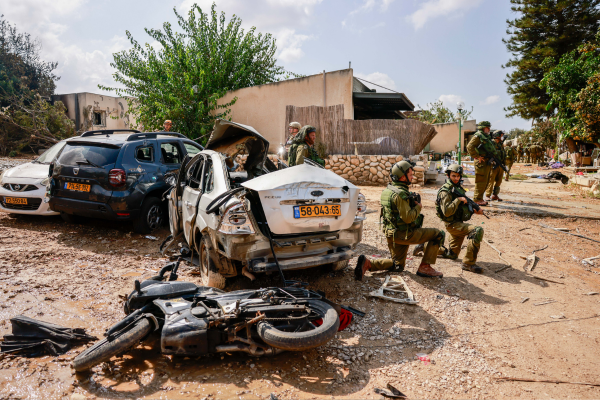‘We are refugees in our own country. Everything is on hold. I don’t know when I will be able to move back into my home.’
By Amelie Botbol, JNS
Some 240,000 Israelis are refugees after Hamas’s savage attack on their communities close to the Gaza Strip on Oct. 7 and Hezbollah’s continued rocket strikes from Lebanon.
The Hamas terrorists took the lives of approximately 1,200 people. The survivors had to evacuate their devasted towns and cities and are being housed in temporary accommodation in other parts of the county, without knowing when they will be able to return to their homes.
“As far as Sderot is concerned, once the Israeli prime minister, the chief of staff and the minister of defense tell us that it is safe to return to Sderot and that there is no threat to the residents, then we will make the correct and safe decision for our residents,” Alon Davidi, mayor of Sderot, told JNS.
Most of the residents of Sderot, a city of 30,000, were relocated to Eilat, the Dead Sea area, Netanya, Tel Aviv and Jerusalem.
“It’s clear to us that we won’t move back until Hamas is fully destroyed. I miss my home. I don’t know what it would take to get me back there. The army will have to regain our trust,” said Adele Raemer, 69, a retired teacher from Kibbutz Nirim, a community situated 4.3 miles east of Khan Yunis, the second-largest city in the Gaza Strip.
“We are refugees in our own country. Everything is on hold. I don’t know when I will be able to move back into my home,” she said.
Raemer recounted how her son-in-law shot a terrorist who stormed into his house while her grandchildren Yuval, 2, Raz, 7, and Ziv, 8, hid under a blanket. The children were briefly evacuated to Eilat but they were so psychologically scarred that they would not leave the hotel.
“They were afraid that terrorists would drive up in a truck. Every noise would send them running to us. My daughter Lilach took them to Kibbutz Ruhama. They are not with their friends, but at least it’s quiet. They feel safe,” Raemer said.
Uriel Laban, a capoeira instructor, was evacuated from Nirim to Eilat with his wife, Aimee, and their newborn son Kai. They were almost burned alive by the Hamas invaders.
“We were in our house when Hamas terrorists came in. We would not let them into the safe room so they set the house on fire. We stayed there for almost six hours trying to stealthily get rid of the smoke amid the gunshots. Kai was only 10 days old at the time,” Laban told JNS.
While Laban and his wife plan to return to Nirim, he is not prepared to compromise on his family’s safety.
“We will go back once the country provides proper security. We will try to rebuild. I want to believe that once I’m there, I will feel safe again. Going back with the community is the best way to recover from this,” Laban said.
In nearby Kibbutz Nir Oz, about 290 of the 400 residents had to evacuate. Others were either murdered or kidnapped by Hamas on Oct. 7. Some of the 80 abducted Nir Oz residents were released as part of the week-long truce between Israel and Hamas, which Hamas later violated.
“Most of us are in a hotel in Eilat. A temporary school was set up in tents for primary-age pupils, and the teenagers joined a high school in Eilat,” Nir Oz spokeswoman Irit Lahav told JNS.
“We do not have the conditions (computer, desk, etc.), or the mental capacity to work. We are busy getting our lives together, after everything was stolen from us. We are worried about the 31 people still held in Gaza,” she added.
Lahav says half of the houses in Nir Oz were destroyed.
“It will take three years to return to Nir Oz. By the end of December, we will hopefully move to apartments in Kiryat Gat, for eight months. Then, we will stay two years in temporary houses, until we can return to Nir Oz,” Lahav said.
In Kfar Aza, another kibbutz on the Gaza border, nearly every home was either burned or riddled with bullets on Oct. 7. The attack claimed the lives of 57 of Kfar Aza’s 750 residents. Eighteen were kidnapped.
“As a parent, my top priority is my child’s safety and I will only go back if I feel that the kibbutz is a safe enough environment for my daughter,” Avidor Schwartzman, 38, a media consultant, told JNS. He was evacuated from Kfar Aza to Kibbutz Shefayim in central Israel with his wife, Keren Flash, and their one-year-old daughter Sa’ar.
The Schwartzmans hid in the safe room for 21 hours as Hamas terrorists marched up his roof and fired bullets at his house.
“My daughter is the real hero here. She did not make the slightest noise, otherwise, we’d all be dead. It was like she knew what was happening,” he said.
Schwartzman’s in-laws—Flash’s parents—were both killed by Hamas terrorists.
“At 5 p.m., we were notified that Hamas terrorists were trying to break into Keren’s parents’ house. We began texting them frantically but our texts remained unanswered. Five days later, we were notified that they were both killed,” he said.
“Kfar Aza is one of the most beautiful places I have ever seen. Everything was just the way it should be. Some days we want to be pioneers, who will rebuild the kibbutz; some days we want to leave everything and start a new life somewhere else in Israel,” Schwartzman added.
He said it is much too soon to contemplate going back as the community is still processing what happened on Oct. 7, with new information being disclosed daily by the media and the army.
“Stories of brutal horrors and unspeakable things are revealed and it’s obviously affecting the disposition of the displaced Kfar Aza residents,” Schwartzman said.
